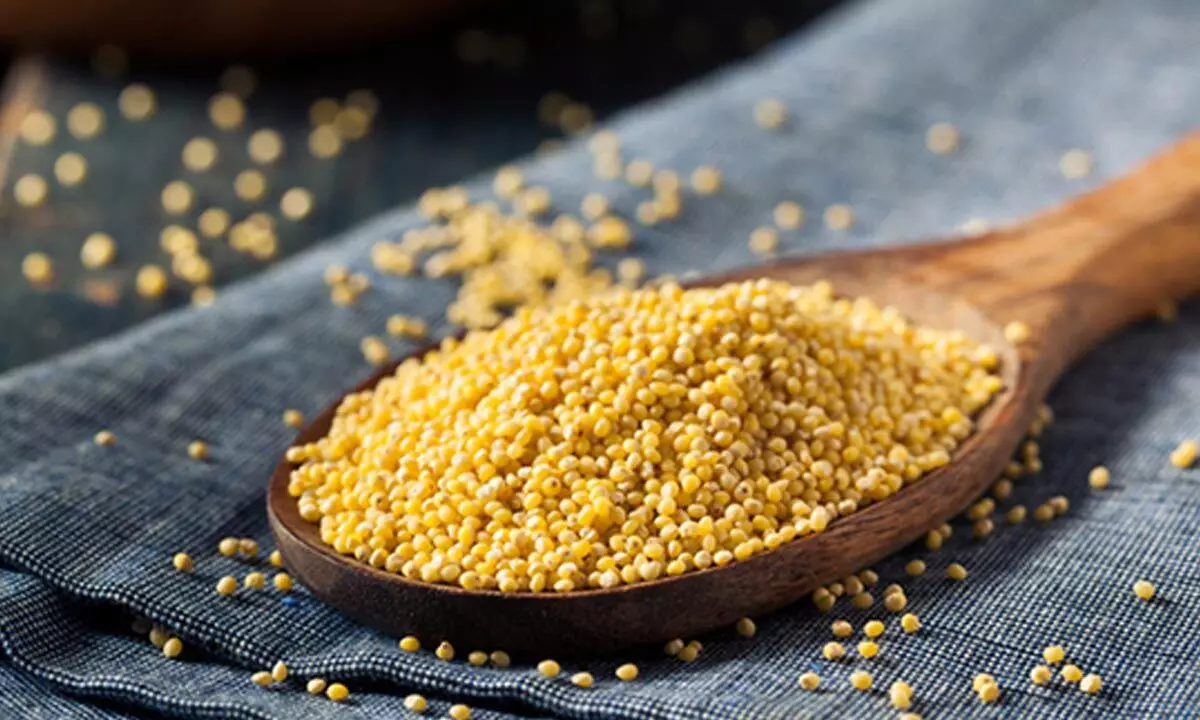'International Year of Millets' calls for major push to the super food
Millets are easy to grow, cost-effective and have immense nutritional value
image for illustrative purpose

In order to reverse the consumption trend, India dedicated 2018 as the 'National Year of Millets'. This was essentially to encourage both production and consumption of millets or nutria-cereals. In a slow but steady progress, the production climbed from 14.52 million tonnes in 2015-2016 to 17.96 million tons in 2020-21
The United Nations has declared 2023 as the 'International Year of Millets' at Indian instance. Towards this, the Department of Agriculture & Farmers Welfare endeavours to spread the millet culture across the world by way of large-scale production and consumption.
Millets have a special stature and significance in Indian agriculture. One of the earliest crops to be planted by mankind was millets apparently dating back to Indus-Sarasvati civilization (3,300 to 1300 BCE).
Millets are consumed by half of the population of Asia and Africa. There are about 6,000 varieties of millet that are known to mankind. Of them, the popular ones from the consumption point include sorghum (jowar), pearl millet (bajra), finger millet (ragi/nachni), brown top (sama), kodu (arke), proso (chena/barr), barnyard (sanwa), and foxtail millet (Kora). Millets rank amongst the best products for boosting one's health since they are gluten-free, good for the digestive system and offer protection from heart diseases.
Another factor that goes is crucial is that compared to other grains, millets are easy to grow and do not need much soil or rain nor as much attention during cultivation as required by rice and wheat.
Millets are a perfect crop in areas where water management is a concern because they prosper in semi-arid climates.
Despite the long tradition of millet intake in India, it has been noticed that between 1972-1973 and 2004-2005, consumption of pearl millet, or bajra, fell by 67 per cent in urban areas and by 59 per cent in the interiors. Another study found that jowar, bajra, maize and ragi provided 23 per cent of India's grain needs in 1983 but accounted for only six percent in 2011.
In order to reverse the consumption trend, India dedicated 2018 as the 'National Year of Millets'. This was essentially to encourage both production and consumption of millets or nutria-cereals. In a slow but steady progress, the production climbed from 14.52 million tonnes in 2015-2016 to 17.96 million tons in 2020-21.
Jowar, bajra and ragi are known as neutral while brown top, kodu, proso, barnyard, and foxtail are deemed positive millets. The popularity of these five has been rising steadily, particularly in the wake of growing awareness that millets are incredibly beneficial to the digestive system and can heal chronic conditions like diabetes.
Here are some reasons that contributed to the rising popularity of millets.
Health advantages: Millets are high in protein, fiber, essential vitamins and minerals like dietary fiber, carbs, protein, healthy fat, calcium, iron, manganese, zinc, potassium and magnesium. They are acknowledged as a nutritional powerhouse. It aids in maintaining immunity levels, weight reduction and overall health. Millets are known to alleviate asthma, lessen migraines and drain out toxins from our bodies, allowing our organs to work optimally.
Government policies: On April 10, 2008, millets were rebranded as 'Nutri Cereals', and 2018 was declared 'National Year of Millets'. The worldwide millets market is expected to have a CARG of 4.5 per cent between 2021 and 2016. The Union and state governments and Indian embassies have been allotted a dedicated month in 2023 to carry out various initiatives to promote IYM and raise awareness about the advantages of millets. The government has scheduled a number of millet-centric promotional events around the country commemorating the International Year of Millets, while also underlining that millets are a vital component of the ensuing G-20 summit that India is hosting.
Boosters for farmers: Millets are one of the simplest crops to cultivate. Because it is a rain-fed crop, it does not require as many fertilizers or as much attention as wheat and rice do. The nourishment values are incredibly high. Millets are easy to plant and adapt extremely well to the changing climatic and environmental conditions.
Future of millets: Surmise to say that in millets lies the future of agriculture. It is a win-win option for cultivation, farmers and consumers given the huge medical advantages. As one that is not too reliant on water, it is also a wonderful option as a crop considering that groundwater levels in the country have declined by a whopping 61 per cent between 2007 and 2017.
It is already seen as a crop that can ensure food security of the world. Since millets are making a comeback with many preferring it several other food products, many cultivators, including locals, are going for millets. Being superior in nutrients and proteins, millets are indeed super foods. The government has to be lauded for launching initiatives that are contributing to an increased patronization of millets.
(The author founder & Managing Directior of Gudmom by 1Organic & Millet Evangelist)

